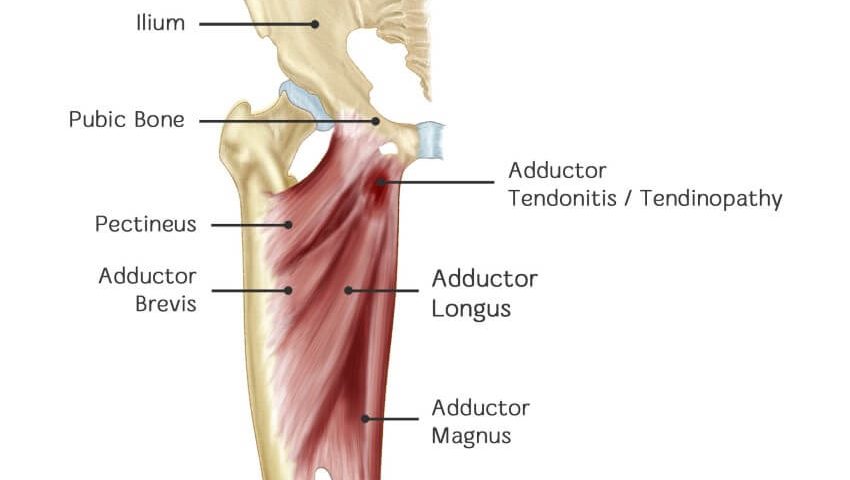
Cupping
February 24, 2019
Rehabilitation concepts for the shoulder
March 14, 2019What is Adductor Tendinopathy?
- You’re in competition, running a marathon, accelerating to beat the last defender or mid pull for a new max deadlift and you feel a pain high up the inside of your thigh near your pubic bone, what could it be?
- Adductor tendinopathy is an umbrella term used to encompass a number of disorders affecting the adductor muscle group where their tendons insert into the pubic bone (enthesis). Problems can range from tendon fibre degeneration to partial/full thickness muscle tears.
- You have five adductors in this group, the pectineus, brevis, longus, magnus and the gracilis with the adductor longus being most commonly affected in adductor tendinopathies.
What can cause adductor tendinopathy?
- Tendon disrepair, degeneration and thickening is caused by chronic tendon overuse and overloading. Tendons that are overloaded struggle to repair due to their notoriously poor blood supply and over time this leads to fiber degeneration and fraying as the body cannot repair the microtearing at the same rate that it is being caused during exercise.
- Muscle tears or ruptures occur when the contractile force produced by the muscle exceeds the strength of the muscle or tendon’s ability to resist this force and the unit fails resulting in a tear.
Risk factors
- Previous adductor injury
- Strength imbalances and asymmetries
- Male gender
- Poor lumbopelvic control
- Weakened or inhibited abdominals
- Overactive or under active hip flexors or abductors
- Chronic knee valgus
- Chronic foot pronation
- Poor conditioning for sport
- Sports involving rapid deceleration and acceleration in different directions
Symptoms of adductor tendinopathy
- It’s common to have superficial groin pain proximally at the adductor enthesis which is aggravated by bringing you’re thigh across you’re midline (hip adduction), resisted hip adduction, explosive changes in direction, kicking a ball or coughing and sneezing may also cause pain. Stiffness in the morning lasting 5-10mins particularily around the enthesis can be indicative of an inflammatory process.
- In most athlete’s cases the pain felt in their adductor is not severe enough in the early stages to force a full withdrawal from sport and so they usually continue to train through this pain until it advances forcing them to stop. This ongoing participation in sport can worsen the condition of the tendon and thus delay recovery.
How is adductor tendinopathy diagnosed?
- A medical professional will ask you in depth questions about your symptom, where it hurts, what makes your pain worse, the mechanism of injury or how it came about as well as special questions to rule in or out other pathology which could be feeding into your pain.
- Depending on the severity of your symptom and disability caused along with the history of how it happened, your medical professional may ask for an MRI to assess the integrity of the adductor enthesis to determine if local swelling is present, the degree of tendon disrepair or to confirm the location and grading of a possible tear. This information provides great insight into what is required in the rehabilitation process and how long the recovery is estimated to take.
Adductor tendinopathy treatment
- Initial intervention includes temporary removal for aggravating sport and avoiding aggravating factors until your symptom is under control. Steps are taken to protect the area, optimally load it, ice, compress and elevate the limb should a tear be present. Paracetamol can be taken to help with pain and non-steroidal anti-inflammatories can be taken after 48 hours as per your doctors advice.
- A corticosteroid injection can be administered to ease local inflammation at the enthesis and allow rehabilitation to start in particularly inflamed cases.
- An active progressive rehabilitation programme is started with range of motion exercises progressing onto isometric, eccentric and concentric exercises to strengthen the muscle-tendon unit. Once isolated strength work is pain free and the patient can demonstrate certain specific strength markers we then progress to functional loading, plyometrics with end stage rehab including a graduated and supervised return to sport.
What happens is adductor tendinopathy goes untreated?
- Pain and disability will continue and eventually you will develop a condition called osteiits pubis in which an instability develops between the two pubic bones which ultimately leads to bone erosion.
What is the prognosis for adductor tendinopathy?
- The prognosis for adductor tendinopathy is very good provided it is identified early and the precipitating painful movements and risk factors are removed. Muscle tears, depending on the severity can range from 4-12 weeks to rehabilitate whereas more chronic tendon degeneration can take up to 6 months. As always, if in pain it’s always best to get it assessed by a professional to keep you happy and healthy in sport.
Redmond C.


